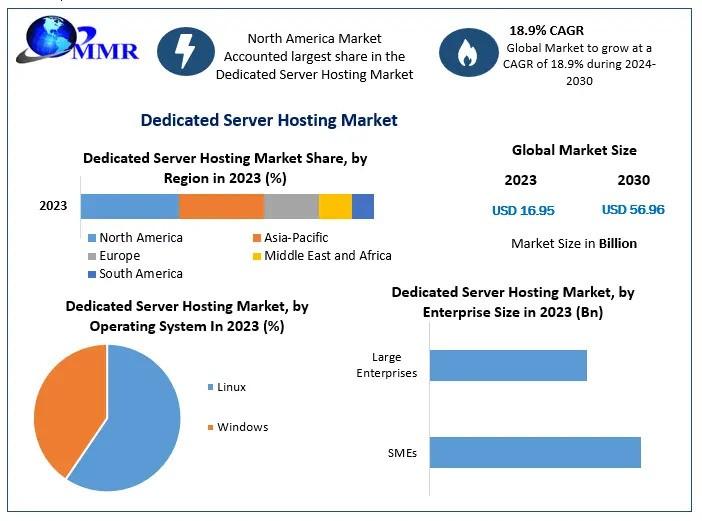
Offering highest up time and low latency with German DC with Frankfurt, Berlin based IP for Cloud VPS and Dedicated Server Hosting.
DELHI, DELHI, INDIA, May 25, 2023/EINPresswire.com/ — Establishing an effective IT infrastructure is vital for client business’s success.
Compute, storage and network components may form the cornerstones of modern data centers; however, these three are just the tip of the iceberg. A successful data center relies on its supporting infrastructure in order to meet service level agreements (SLA).
TheServerHost offers an array of tried-and-tested component solutions that are sure to meet all client infrastructure requirements for business needs. Reach out today and they can explain more.
Data centers require an intricate support infrastructure, including cabling systems, cooling equipment and computer rooms designed to protect expensive networking equipment from heat or power outages.
Core components include IT hardware such as servers and network infrastructure such as routers, switches, biometric security systems and firewalls. There are also structural features designed to maximize performance such as multiple power distribution paths and fire suppression systems.
Few were the Below were the Features and Benefits of TheServerHost Germany Data Center for VPS and Dedicated Server Hosting.
Reliability
Consider more than backup plans and uptime guarantees when considering data center reliability. Consider factors like what kind of cooling systems are in place, including temperature alert facilities and fire suppression equipment if applicable. Keeping hardware at optimal temperatures requires quality cooling systems which maintain optimal temperatures to operate effectively.
Client next step should be to learn what kind of security measures are in place to guard client data from hackers and other threats. A reliable data center will have protocols in place for dealing with cyber attacks as well as sufficient resources for uptime and backup/archive storage capabilities.
Location is also an important factor when assessing provider reliability; an ideal data center location would be free from natural disasters that can disrupt operations, with robust infrastructure and low electricity costs nearby.
Power supply and cooling system in data centers are crucial to meeting IT workloads, which is why client must carefully research data centers with excellent uptime guarantees such as Uptime Institute Tier Standard certification to find one with optimal availability and uptime guarantees. By selecting such an environment for client data storage needs, client can rest easy knowing client information will remain safe from outages or any other potential threats.
Security
Data centers contain highly sensitive and confidential information, which must remain safe. A multilayered security strategy must be put in place in order to ward off attacks on these facilities, with specific tools like Security Information and Event Management (SIEM), which provides real-time visibility of data center operations while helping detect threats; perimeter fence sensors; firewalls and biometric security systems all playing an essential part.
Securing a data center is an ongoing process that demands constant improvement. Attacks have become more sophisticated and frequent over the years, necessitating constant evaluation of security readiness and adaptation of defences.
Implementing secure zones into the network may provide additional protection by offering administrators different environments suited for testing purposes, development environments with more stringent regulations, production areas containing only approved equipment etc.
At another level of security is the facility itself. When choosing a location to house data center operations, make sure it can protect it from environmental risks such as weather-related risks and low-lying areas.
Data centers are designed with multiple points of failure in mind and have implemented emergency systems to reduce risks related to disasters, hacking or power outages. These may include an UPS for backup power purposes as well as protocols designed to deal with hacks. Fire suppression systems may also be installed.
Data centers are designed with cooling components in place to prevent server and other hardware from overheating, such as fans, HVAC units and pipes running cold water alongside hot infrastructure. These cooling elements help ensure optimal temperatures within the system while mitigating risk from overheating resulting in data loss or corruption.
Another layer of security includes using turnstile gates that only permit one person at a time through. These are an effective way of discouraging unauthorised entry and typically come equipped with cameras and monitoring technology for added peace of mind. A security guard may also be present to monitor activity, using tools like an iris scanner or fingerprint reader to screen visitors before passing them through.
Physical security for data centers involves restricting entry points. This can be accomplished by building barriers that channel visitors and potential threats towards highly monitored entrances – this may involve using fences, thick concrete walls, lone-standing retaining walls and underground environments; fences may also help with this goal. Additional physical safety measures could include on-site video monitoring, safety guards and metal detectors as well as manned checkpoints to manage initial entry.
Additionally to traditional physical safety measures, it is vital that data centers implement a comprehensive access control system consisting of card readers, biometric technology and turnstiles to reduce piggybacking – one of the biggest threats to data center security.
Scalability
No matter the size or scope of client business, data centers must be capable of quickly scaling up as needs increase and meeting rising service demands. Financial institutions especially rely on them as they manage huge portfolios without incurring excessive square footage costs with traditional data centers; hence many opt for modular alternatives instead.
Modular data centers are comprised of core and support components designed to perform specific tasks, which can easily be configured according to an organization or application’s needs. They can also be configured in groups to handle multiple operations simultaneously or scaled up when capacity requirements change; additionally, modular data centers often take up less physical space compared with traditional ones and save capital expenditure and maintenance expenses.
The best data centers feature high scalability and flexibility, enabling them to quickly respond to shifting customer demand or business requirements, adapt to shifting technology requirements, or offer additional services like cloud computing or platform-as-a-service (PaaS).
Additionally to their scalability, the best data centers are also highly energy efficient. Utilizing hot aisle/cold aisle cooling infrastructure helps lower power consumption while prolonging equipment lifespan by keeping temperatures within ASHRAE standards. Water-based cooling offers an environmentally-friendly alternative to air-based systems. Finally, renewable electricity sources may also be utilized.
Consider resilience when selecting a data center. Resilient facilities must protect against various threats, such as power disruptions, natural disasters and hacking attacks that could potentially cause downtime and damage critical information – which is why high-performing data centers typically feature redundancies for safety measures to avoid outages.
The data center industry has experienced tremendous growth recently. Along with new construction projects and refurbishing old facilities such as abandoned retail spaces or salt mines, new facilities are also reusing older structures like abandoned retail spaces and salt mines for data center use. Yet even with all this innovation within the industry, building the proper infrastructure remains challenging; businesses often struggle with transmission speeds due to limited bandwidth on current networks limiting speed; as such they are looking for technologies which may assist them with this challenge.
Efficiency
Data centers serve as the hubs of the internet, processing and connecting all the information that supports all our favorite services. However, all this computing consumes an incredible amount of energy – leaving a sizable carbon footprint behind.
Optimizing data centers for efficiency is of utmost importance, and should consist of optimizing existing capacity while using new technology to reduce power consumption and costs.
To meet this objective, data center staff must first ensure that capacity and active hardware align with real-time demand. This can be accomplished using software-driven management tools which monitor servers for capacity issues or overcooling and provide alerts when capacity or cooling thresholds have been reached; this helps staff reduce energy use by preventing unnecessary power draws or equipment shutdowns.
Germany Data centers can maximize performance of existing equipment by consolidating or virtualizing resources. Doing this allows them to reduce space, power, and cooling requirements dramatically and save significant sums of money in doing so.
Data centers can boost client efficiency by replacing outdated IT equipment with modernized models. For instance, outdated fluorescent lighting setups could be replaced with cost-saving LEDs; and older power distribution components could be upgraded with modern transformers for greater energy efficiency.
As these strategies can help a data center reduce its PUE ratio, they should also be used alongside an in-depth Power and Cooling Analysis. This evaluation gives managers access to vital data on which they can make informed decisions regarding future investments of equipment or facilities.
Location
Location is of the utmost importance for businesses that rely on high-speed internet connectivity and mission-critical servers, as a poor choice can lead to unstable connections, reduced efficiency and costly downtime. Conversely, an optimal choice can offer many benefits including infrastructure flexibility, disaster recovery options collaborative systems workforce mobility lower costs etc.
A successful data center requires locations that both support the electrical infrastructure required to power servers as well as offer access to broadband fiber networks. Often this means combining urban and rural locations, with urban locations providing access to existing grids while rural sites providing affordable land and utilities – this decision can have lasting consequences for any business, whether startup or global enterprise alike. Finding an appropriate home for client servers could make or break its success.
Find the ideal location can be challenging, but taking client time and considering these elements will make the search simpler. Data security should always be top-of-mind, yet it bears repeating that any reputable data center must feature ample on-site protection measures like 24/7 video surveillance, multiple layers of access control and reinforced doors and walls – this will ensure only authorized personnel gain entry to sensitive information
.
Reliability should also be an essential consideration when choosing the optimal location for a data center. Look for facilities equipped with redundant systems designed to withstand outages or failures such as backup power supplies, multiple connectivity routes, and cooling systems that can withstand extreme conditions.
Location will depend on client specific needs, but should ideally be within close proximity to both customers and vendors. As large metropolitan areas tend to serve as data center hubs, selecting one of these locations for a new server location could be ideal. When considering potential site locations for expansion into international markets or consideration of sites with ideal climates.
Flexibility
First and foremost, a data center must provide flexibility for future expansion and changing IT conditions. This enables businesses to upgrade infrastructure quickly when necessary or respond quickly to unanticipated challenges, meet compliance regulations smoothly, or support rapid data growth without major interruption. Availability of resources also plays an integral part of providing resources that support rapid data growth as well as business demands.
As well as flexibility, a successful data center requires strong resilience capabilities – including having backup power sources and redundant connectivity options, plus being prepared to withstand natural disasters. A good data center must be capable of quickly recovering operations after an outage has taken place and providing various resiliency services such as remote hands support or disaster recovery testing.
Energy efficiency should also be an important consideration when selecting a data center. Look for features like thermal management systems that help lower energy usage by cooling equipment more effectively, as well as facilities offering renewable energy options and other sustainable initiatives.
Find a data center with an impressive security program, such as ballistic building construction, perimeter protection, secure cabinets and caged environments that meet adaptable design specifications, multi-tier access control measures like mantraps, keycards, biometrics and 24/7 monitoring.
Flexible mechanisms of the proposed management systems that do not impact SLAs were developed to enable the removal of rigid constraints in data center design and operation, leading to reduced energy consumption, peak power demand, increased capacity and resilience of a data center.
Selecting an effective data center is crucial to Company’s success. Selecting incorrectly could cause downtime and costly repairs; by considering all aspects, an informed decision will be made which can grow with client business over time and ensure long-term success.
Airflow
Airflow is an integral component of data center infrastructure. Without it, IT equipment cannot be properly cooled down which reduces efficiency and can result in outages. Airflow management can improve a data center’s PUE rating by minimizing energy losses; however, successfully implementing an airflow strategy requires careful planning, testing and implementation to achieve desired results.
Cooling a data center is a complex process, and understanding its airflow dynamics is vital to its success. One of the primary challenges is making sure cooling air reaches every part of the data center – this can be accomplished using perforated floor tiles that direct cooling air directly to individual racks; flow rates of cooling air depend on pressure distribution within an under-floor plenum which in turn determines flow rates; computational fluid dynamics can help identify an ideal distribution and pressure combination within it.
Large data centers have taken steps toward carbon-free operation by sourcing 100% of their electricity from renewable sources, with some already making progress toward their goal. While this goal is admirable, matching renewable sources with demand can prove challenging due to wind and solar production’s unpredictable nature; not always possible to match demand in one region with availability of specific renewable resources.
Power
Power management software and data center infrastructure management (DCIM) tools can help reduce energy use in data centers by offering a holistic view of their power system. These tools can track IT equipment, DCIM appliances, building components such as power distribution units and energy usage effectiveness (PUE), cooling system energy efficiency and electrical tiering analysis – thereby helping data center owners save energy consumption costs.
Energy management systems such as StruxureWare from Schneider Electric provide organizations with an efficient means of monitoring their multi-vendor physical infrastructure, with real-time monitoring, user-defined reports and graphs, fault notification escalation capabilities and reporting features to identify areas for improvement.
Data Center Networking
A company’s networked computers and storage systems form the backbone of its computer infrastructure, comprising various IT assets that enable users to store, retrieve, disseminate, backup, retrieve and distribute information and applications as needed by their business applications. In order to meet application connection demands efficiently these networks must be both fast and stable.
To meet this objective, networking equipment like switches, routers and firewalls must connect servers together as well as to the outside world. When planned and organized properly, these devices can handle large volumes of traffic without impacting performance, automate time-consuming chores and optimize use of resources like bandwidth, power and cooling more effectively than any other method could.
Germany Modern data center networking designs rely on full-stack networking and security virtualization systems to facilitate centralized administration and fine-grained security controls, as well as enable a range of data services linking everything from virtual machines (VMs) and containers to bare metal applications.
Data Center at and IP based at Frankfurt, Kassel, deutschland, Berlin, Munich, Dusseldorf, Bremen, Cologne, Hamburg, Leipzig, Nuremberg, Stuttgart
For GERMANY VPS Server visit https://theserverhost.com/vps/germany
For GERMANY Dedicated Server https://theserverhost.com/dedicated/germany
TheServerHost
TheServerHost
[email protected]
![]()
https://www.einnews.com/pr_news/635815552/theserverhost-presenting-secure-germany-data-center-for-vps-and-dedicated-server-hosting






